FMEC Modeling & Security Issues: Comprehensive Research Report
VerifiedAdded on 2021/04/17
|21
|6860
|37
Report
AI Summary
This report investigates the critical aspects of FMEC (Fog and Mobile Edge Computing) modeling and the associated security challenges within cloud computing environments. The research highlights the evolution of cloud computing, its benefits, and the emergence of FMEC to address limitations such as latency and mobility support. The report delves into the security issues impacting cloud applications, including the need for secure services and the complexities of heterogeneous devices within the fog infrastructure. It emphasizes the significance of understanding these concerns to develop effective control measures. The research identifies research gaps, particularly in protecting the fog infrastructure, and proposes a revolutionary approach to security service selection. This involves choosing optimal security services based on mobile user requirements within the FMEC environment, considering various quality-of-service parameters. The report underscores the importance of addressing security threats at all infrastructure levels and the need for continuous research and analysis to enhance the security of FMEC systems.
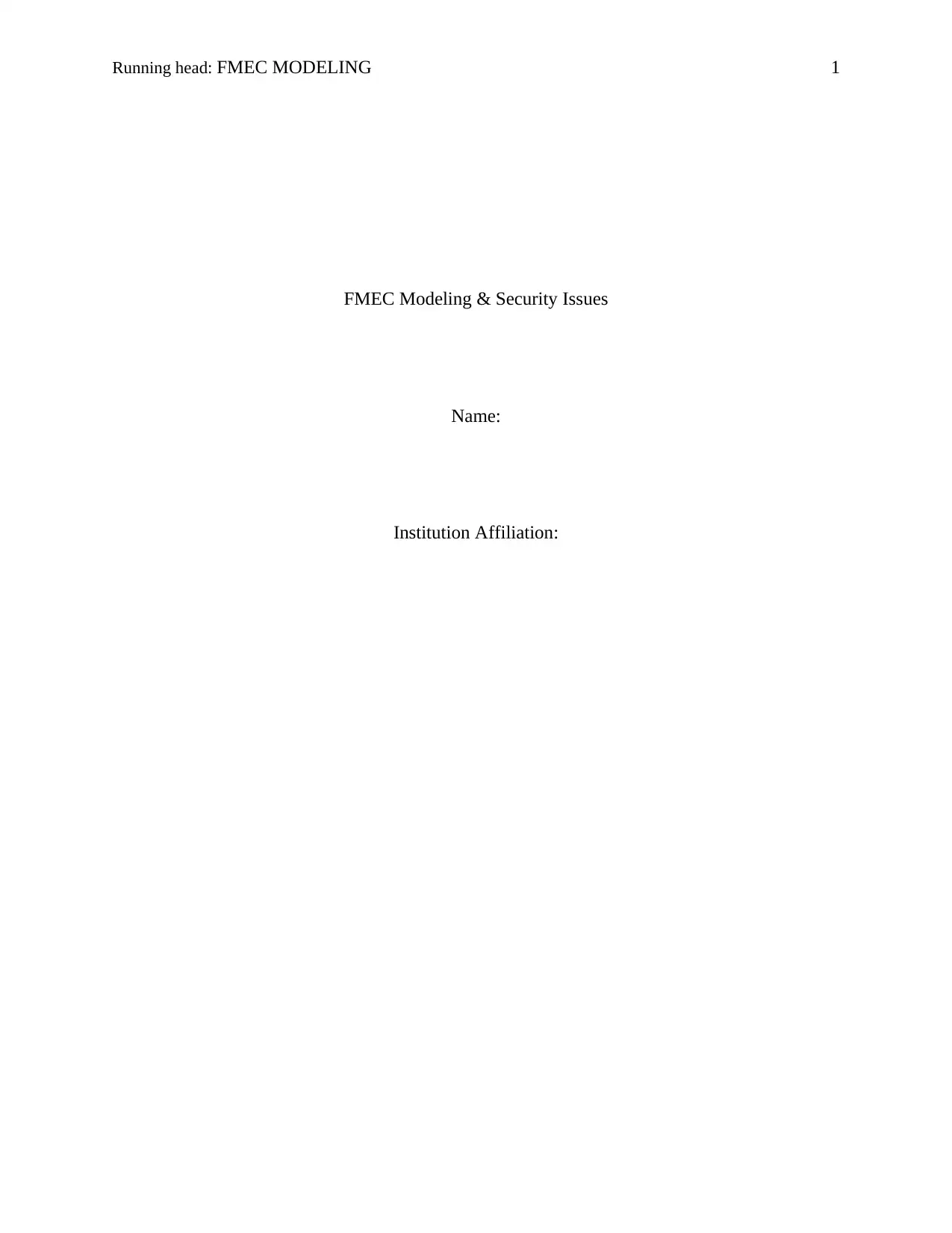
Running head: FMEC MODELING 1
FMEC Modeling & Security Issues
Name:
Institution Affiliation:
FMEC Modeling & Security Issues
Name:
Institution Affiliation:
Paraphrase This Document
Need a fresh take? Get an instant paraphrase of this document with our AI Paraphraser
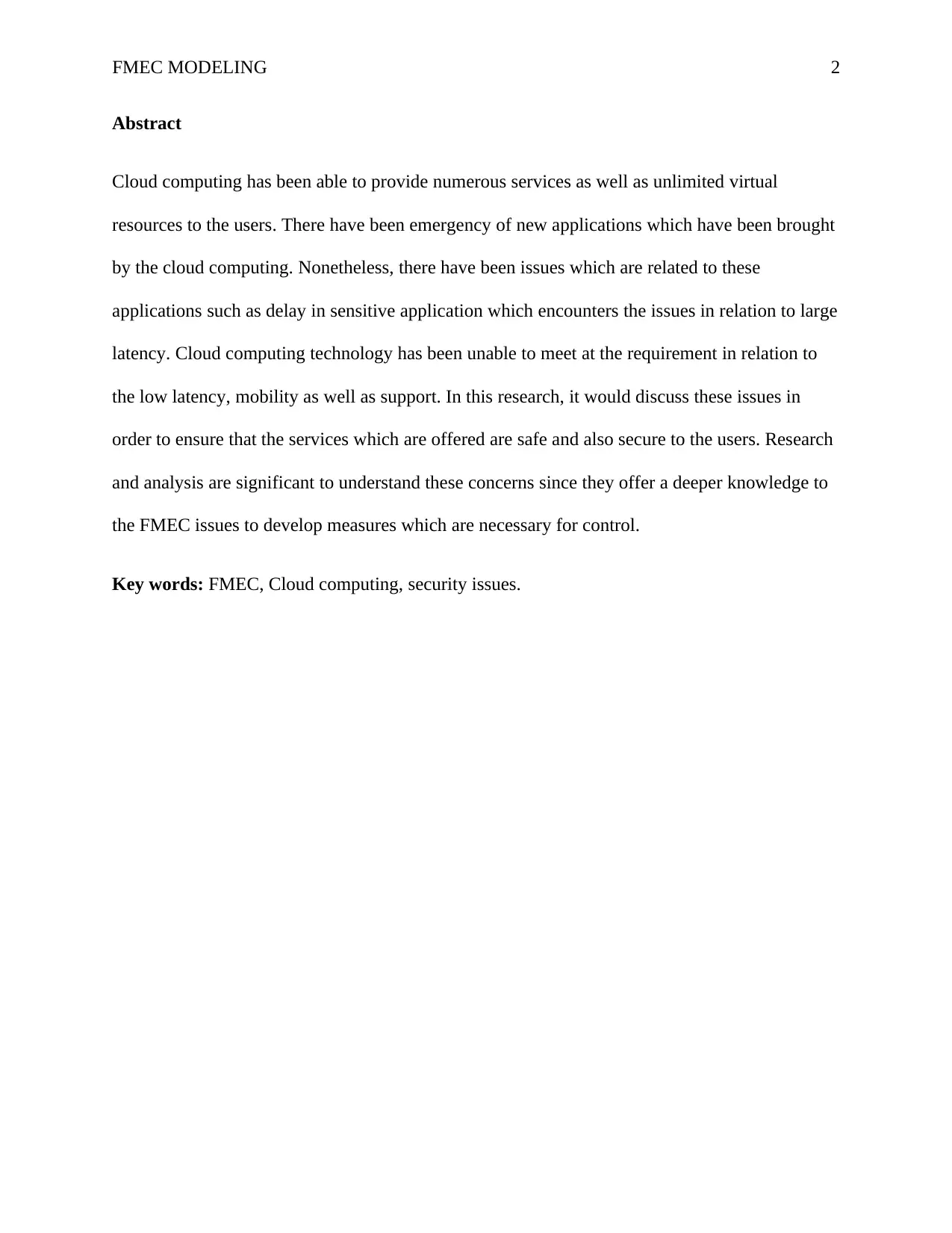
FMEC MODELING 2
Abstract
Cloud computing has been able to provide numerous services as well as unlimited virtual
resources to the users. There have been emergency of new applications which have been brought
by the cloud computing. Nonetheless, there have been issues which are related to these
applications such as delay in sensitive application which encounters the issues in relation to large
latency. Cloud computing technology has been unable to meet at the requirement in relation to
the low latency, mobility as well as support. In this research, it would discuss these issues in
order to ensure that the services which are offered are safe and also secure to the users. Research
and analysis are significant to understand these concerns since they offer a deeper knowledge to
the FMEC issues to develop measures which are necessary for control.
Key words: FMEC, Cloud computing, security issues.
Abstract
Cloud computing has been able to provide numerous services as well as unlimited virtual
resources to the users. There have been emergency of new applications which have been brought
by the cloud computing. Nonetheless, there have been issues which are related to these
applications such as delay in sensitive application which encounters the issues in relation to large
latency. Cloud computing technology has been unable to meet at the requirement in relation to
the low latency, mobility as well as support. In this research, it would discuss these issues in
order to ensure that the services which are offered are safe and also secure to the users. Research
and analysis are significant to understand these concerns since they offer a deeper knowledge to
the FMEC issues to develop measures which are necessary for control.
Key words: FMEC, Cloud computing, security issues.
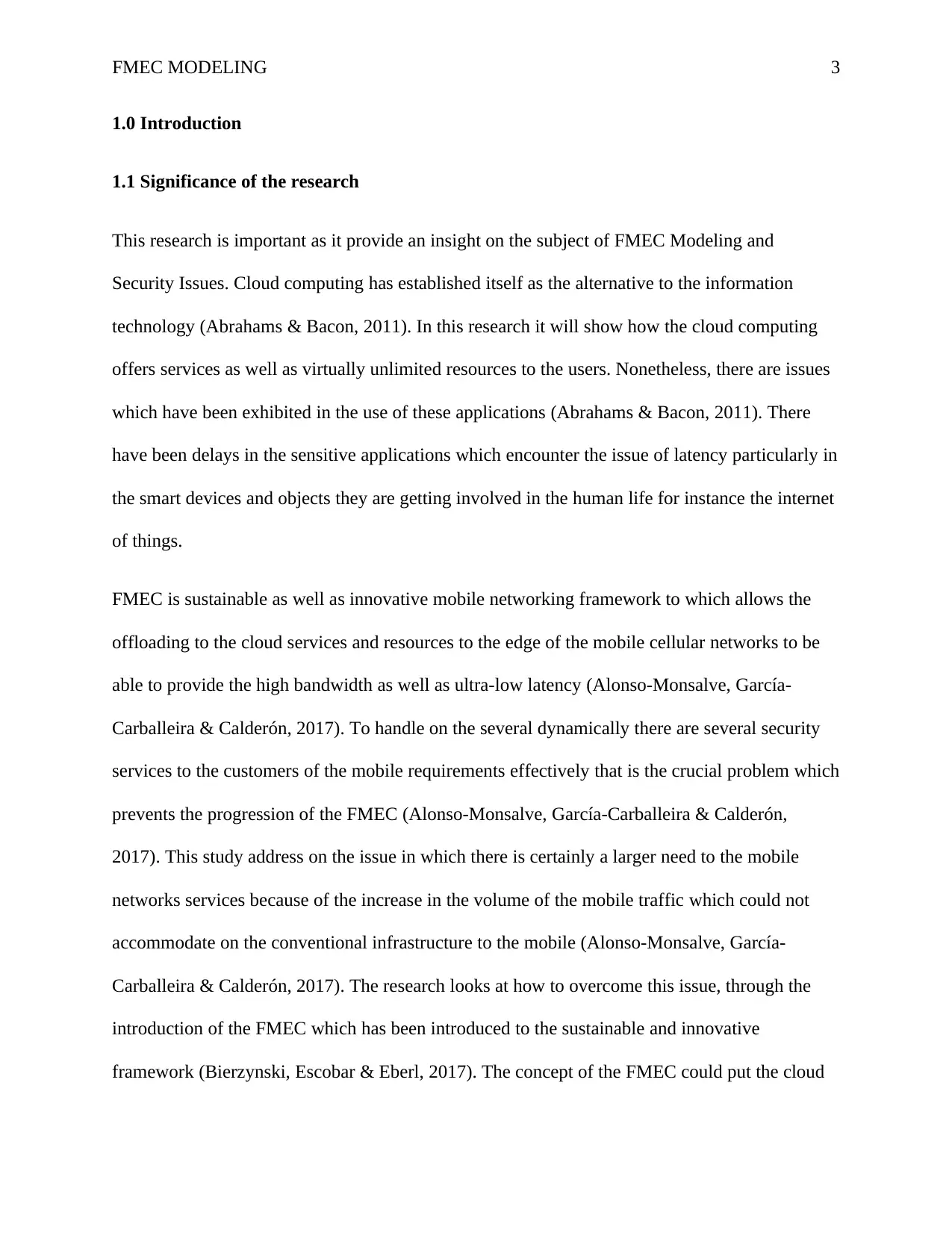
FMEC MODELING 3
1.0 Introduction
1.1 Significance of the research
This research is important as it provide an insight on the subject of FMEC Modeling and
Security Issues. Cloud computing has established itself as the alternative to the information
technology (Abrahams & Bacon, 2011). In this research it will show how the cloud computing
offers services as well as virtually unlimited resources to the users. Nonetheless, there are issues
which have been exhibited in the use of these applications (Abrahams & Bacon, 2011). There
have been delays in the sensitive applications which encounter the issue of latency particularly in
the smart devices and objects they are getting involved in the human life for instance the internet
of things.
FMEC is sustainable as well as innovative mobile networking framework to which allows the
offloading to the cloud services and resources to the edge of the mobile cellular networks to be
able to provide the high bandwidth as well as ultra-low latency (Alonso-Monsalve, García-
Carballeira & Calderón, 2017). To handle on the several dynamically there are several security
services to the customers of the mobile requirements effectively that is the crucial problem which
prevents the progression of the FMEC (Alonso-Monsalve, García-Carballeira & Calderón,
2017). This study address on the issue in which there is certainly a larger need to the mobile
networks services because of the increase in the volume of the mobile traffic which could not
accommodate on the conventional infrastructure to the mobile (Alonso-Monsalve, García-
Carballeira & Calderón, 2017). The research looks at how to overcome this issue, through the
introduction of the FMEC which has been introduced to the sustainable and innovative
framework (Bierzynski, Escobar & Eberl, 2017). The concept of the FMEC could put the cloud
1.0 Introduction
1.1 Significance of the research
This research is important as it provide an insight on the subject of FMEC Modeling and
Security Issues. Cloud computing has established itself as the alternative to the information
technology (Abrahams & Bacon, 2011). In this research it will show how the cloud computing
offers services as well as virtually unlimited resources to the users. Nonetheless, there are issues
which have been exhibited in the use of these applications (Abrahams & Bacon, 2011). There
have been delays in the sensitive applications which encounter the issue of latency particularly in
the smart devices and objects they are getting involved in the human life for instance the internet
of things.
FMEC is sustainable as well as innovative mobile networking framework to which allows the
offloading to the cloud services and resources to the edge of the mobile cellular networks to be
able to provide the high bandwidth as well as ultra-low latency (Alonso-Monsalve, García-
Carballeira & Calderón, 2017). To handle on the several dynamically there are several security
services to the customers of the mobile requirements effectively that is the crucial problem which
prevents the progression of the FMEC (Alonso-Monsalve, García-Carballeira & Calderón,
2017). This study address on the issue in which there is certainly a larger need to the mobile
networks services because of the increase in the volume of the mobile traffic which could not
accommodate on the conventional infrastructure to the mobile (Alonso-Monsalve, García-
Carballeira & Calderón, 2017). The research looks at how to overcome this issue, through the
introduction of the FMEC which has been introduced to the sustainable and innovative
framework (Bierzynski, Escobar & Eberl, 2017). The concept of the FMEC could put the cloud
⊘ This is a preview!⊘
Do you want full access?
Subscribe today to unlock all pages.

Trusted by 1+ million students worldwide
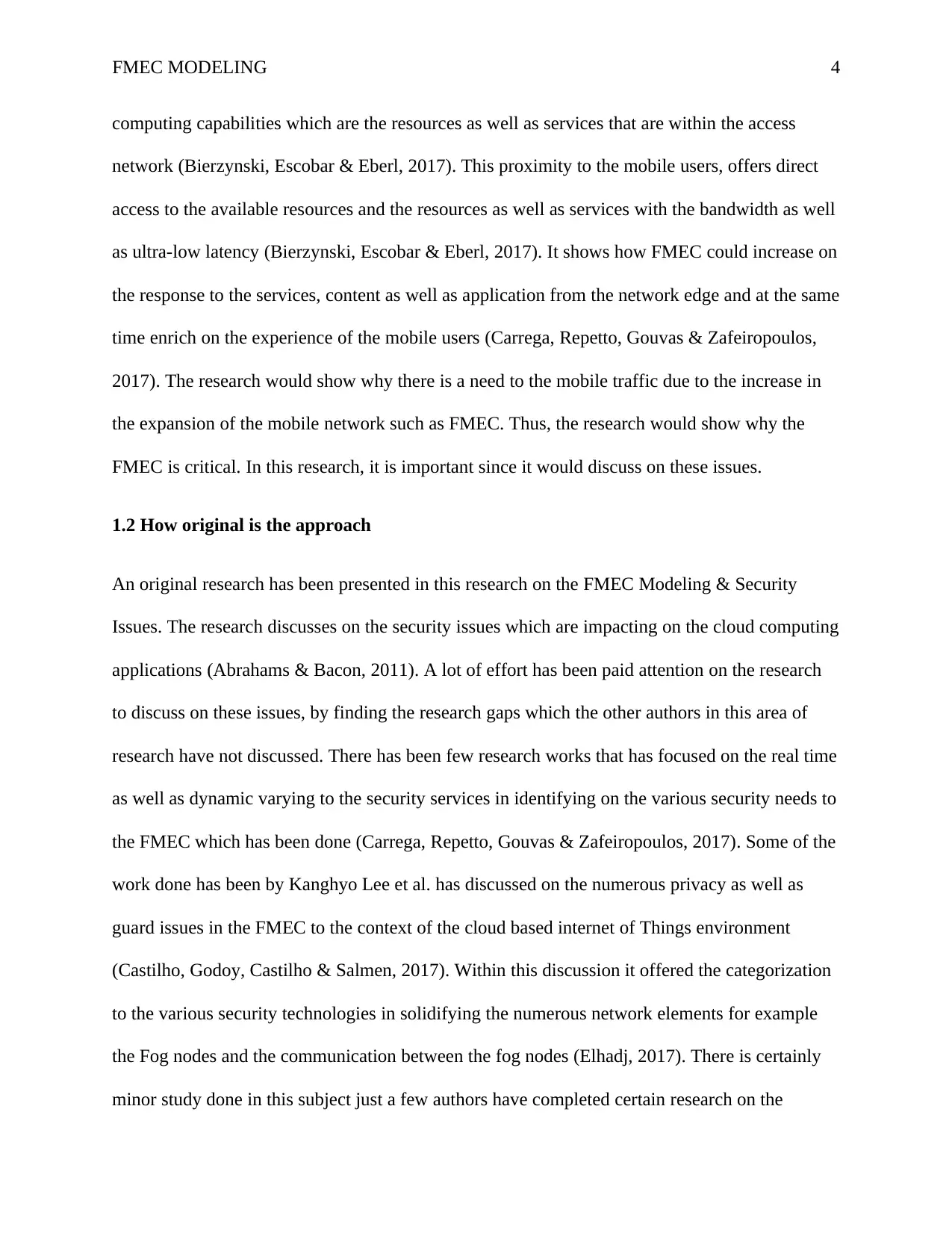
FMEC MODELING 4
computing capabilities which are the resources as well as services that are within the access
network (Bierzynski, Escobar & Eberl, 2017). This proximity to the mobile users, offers direct
access to the available resources and the resources as well as services with the bandwidth as well
as ultra-low latency (Bierzynski, Escobar & Eberl, 2017). It shows how FMEC could increase on
the response to the services, content as well as application from the network edge and at the same
time enrich on the experience of the mobile users (Carrega, Repetto, Gouvas & Zafeiropoulos,
2017). The research would show why there is a need to the mobile traffic due to the increase in
the expansion of the mobile network such as FMEC. Thus, the research would show why the
FMEC is critical. In this research, it is important since it would discuss on these issues.
1.2 How original is the approach
An original research has been presented in this research on the FMEC Modeling & Security
Issues. The research discusses on the security issues which are impacting on the cloud computing
applications (Abrahams & Bacon, 2011). A lot of effort has been paid attention on the research
to discuss on these issues, by finding the research gaps which the other authors in this area of
research have not discussed. There has been few research works that has focused on the real time
as well as dynamic varying to the security services in identifying on the various security needs to
the FMEC which has been done (Carrega, Repetto, Gouvas & Zafeiropoulos, 2017). Some of the
work done has been by Kanghyo Lee et al. has discussed on the numerous privacy as well as
guard issues in the FMEC to the context of the cloud based internet of Things environment
(Castilho, Godoy, Castilho & Salmen, 2017). Within this discussion it offered the categorization
to the various security technologies in solidifying the numerous network elements for example
the Fog nodes and the communication between the fog nodes (Elhadj, 2017). There is certainly
minor study done in this subject just a few authors have completed certain research on the
computing capabilities which are the resources as well as services that are within the access
network (Bierzynski, Escobar & Eberl, 2017). This proximity to the mobile users, offers direct
access to the available resources and the resources as well as services with the bandwidth as well
as ultra-low latency (Bierzynski, Escobar & Eberl, 2017). It shows how FMEC could increase on
the response to the services, content as well as application from the network edge and at the same
time enrich on the experience of the mobile users (Carrega, Repetto, Gouvas & Zafeiropoulos,
2017). The research would show why there is a need to the mobile traffic due to the increase in
the expansion of the mobile network such as FMEC. Thus, the research would show why the
FMEC is critical. In this research, it is important since it would discuss on these issues.
1.2 How original is the approach
An original research has been presented in this research on the FMEC Modeling & Security
Issues. The research discusses on the security issues which are impacting on the cloud computing
applications (Abrahams & Bacon, 2011). A lot of effort has been paid attention on the research
to discuss on these issues, by finding the research gaps which the other authors in this area of
research have not discussed. There has been few research works that has focused on the real time
as well as dynamic varying to the security services in identifying on the various security needs to
the FMEC which has been done (Carrega, Repetto, Gouvas & Zafeiropoulos, 2017). Some of the
work done has been by Kanghyo Lee et al. has discussed on the numerous privacy as well as
guard issues in the FMEC to the context of the cloud based internet of Things environment
(Castilho, Godoy, Castilho & Salmen, 2017). Within this discussion it offered the categorization
to the various security technologies in solidifying the numerous network elements for example
the Fog nodes and the communication between the fog nodes (Elhadj, 2017). There is certainly
minor study done in this subject just a few authors have completed certain research on the
Paraphrase This Document
Need a fresh take? Get an instant paraphrase of this document with our AI Paraphraser
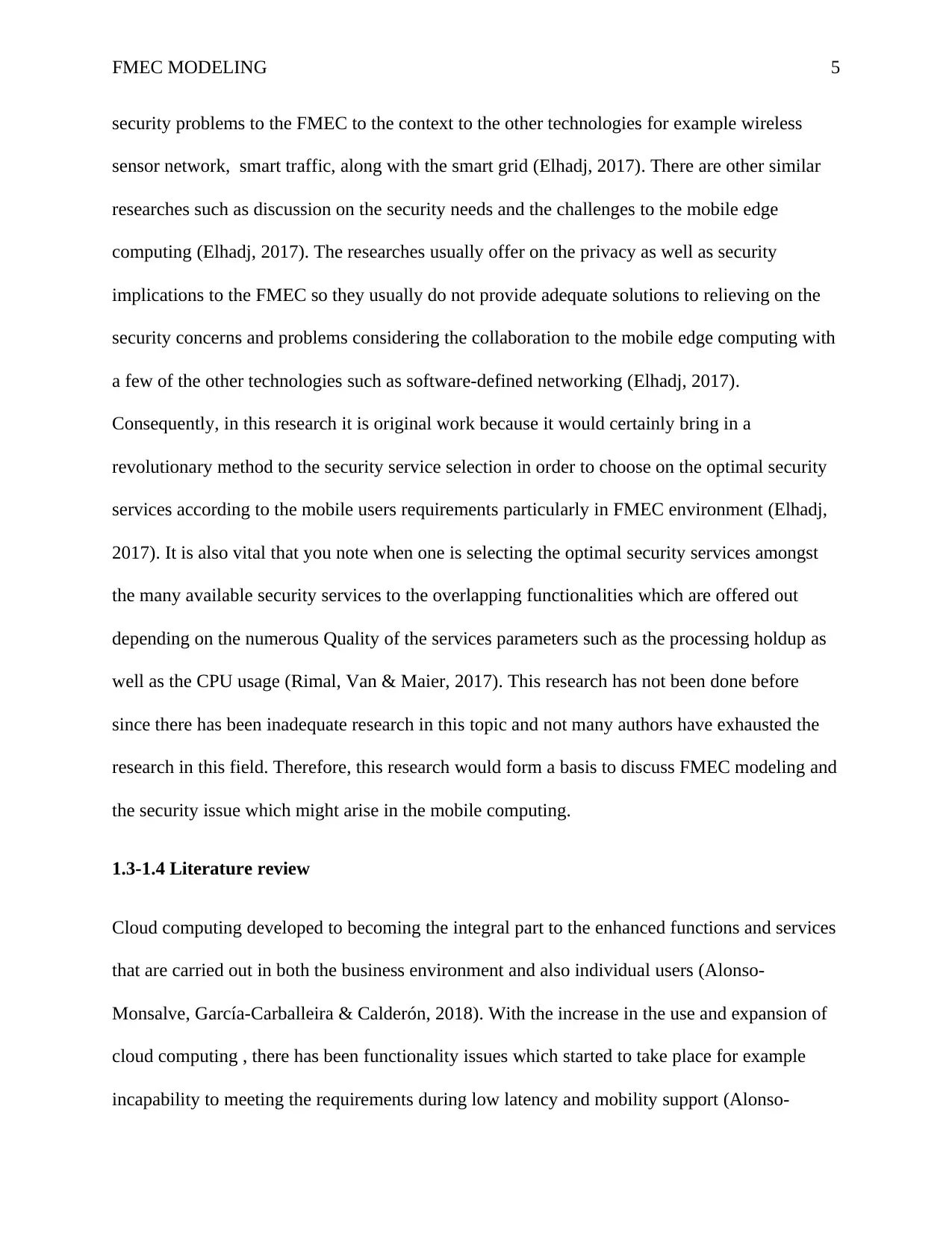
FMEC MODELING 5
security problems to the FMEC to the context to the other technologies for example wireless
sensor network, smart traffic, along with the smart grid (Elhadj, 2017). There are other similar
researches such as discussion on the security needs and the challenges to the mobile edge
computing (Elhadj, 2017). The researches usually offer on the privacy as well as security
implications to the FMEC so they usually do not provide adequate solutions to relieving on the
security concerns and problems considering the collaboration to the mobile edge computing with
a few of the other technologies such as software-defined networking (Elhadj, 2017).
Consequently, in this research it is original work because it would certainly bring in a
revolutionary method to the security service selection in order to choose on the optimal security
services according to the mobile users requirements particularly in FMEC environment (Elhadj,
2017). It is also vital that you note when one is selecting the optimal security services amongst
the many available security services to the overlapping functionalities which are offered out
depending on the numerous Quality of the services parameters such as the processing holdup as
well as the CPU usage (Rimal, Van & Maier, 2017). This research has not been done before
since there has been inadequate research in this topic and not many authors have exhausted the
research in this field. Therefore, this research would form a basis to discuss FMEC modeling and
the security issue which might arise in the mobile computing.
1.3-1.4 Literature review
Cloud computing developed to becoming the integral part to the enhanced functions and services
that are carried out in both the business environment and also individual users (Alonso-
Monsalve, García-Carballeira & Calderón, 2018). With the increase in the use and expansion of
cloud computing , there has been functionality issues which started to take place for example
incapability to meeting the requirements during low latency and mobility support (Alonso-
security problems to the FMEC to the context to the other technologies for example wireless
sensor network, smart traffic, along with the smart grid (Elhadj, 2017). There are other similar
researches such as discussion on the security needs and the challenges to the mobile edge
computing (Elhadj, 2017). The researches usually offer on the privacy as well as security
implications to the FMEC so they usually do not provide adequate solutions to relieving on the
security concerns and problems considering the collaboration to the mobile edge computing with
a few of the other technologies such as software-defined networking (Elhadj, 2017).
Consequently, in this research it is original work because it would certainly bring in a
revolutionary method to the security service selection in order to choose on the optimal security
services according to the mobile users requirements particularly in FMEC environment (Elhadj,
2017). It is also vital that you note when one is selecting the optimal security services amongst
the many available security services to the overlapping functionalities which are offered out
depending on the numerous Quality of the services parameters such as the processing holdup as
well as the CPU usage (Rimal, Van & Maier, 2017). This research has not been done before
since there has been inadequate research in this topic and not many authors have exhausted the
research in this field. Therefore, this research would form a basis to discuss FMEC modeling and
the security issue which might arise in the mobile computing.
1.3-1.4 Literature review
Cloud computing developed to becoming the integral part to the enhanced functions and services
that are carried out in both the business environment and also individual users (Alonso-
Monsalve, García-Carballeira & Calderón, 2018). With the increase in the use and expansion of
cloud computing , there has been functionality issues which started to take place for example
incapability to meeting the requirements during low latency and mobility support (Alonso-
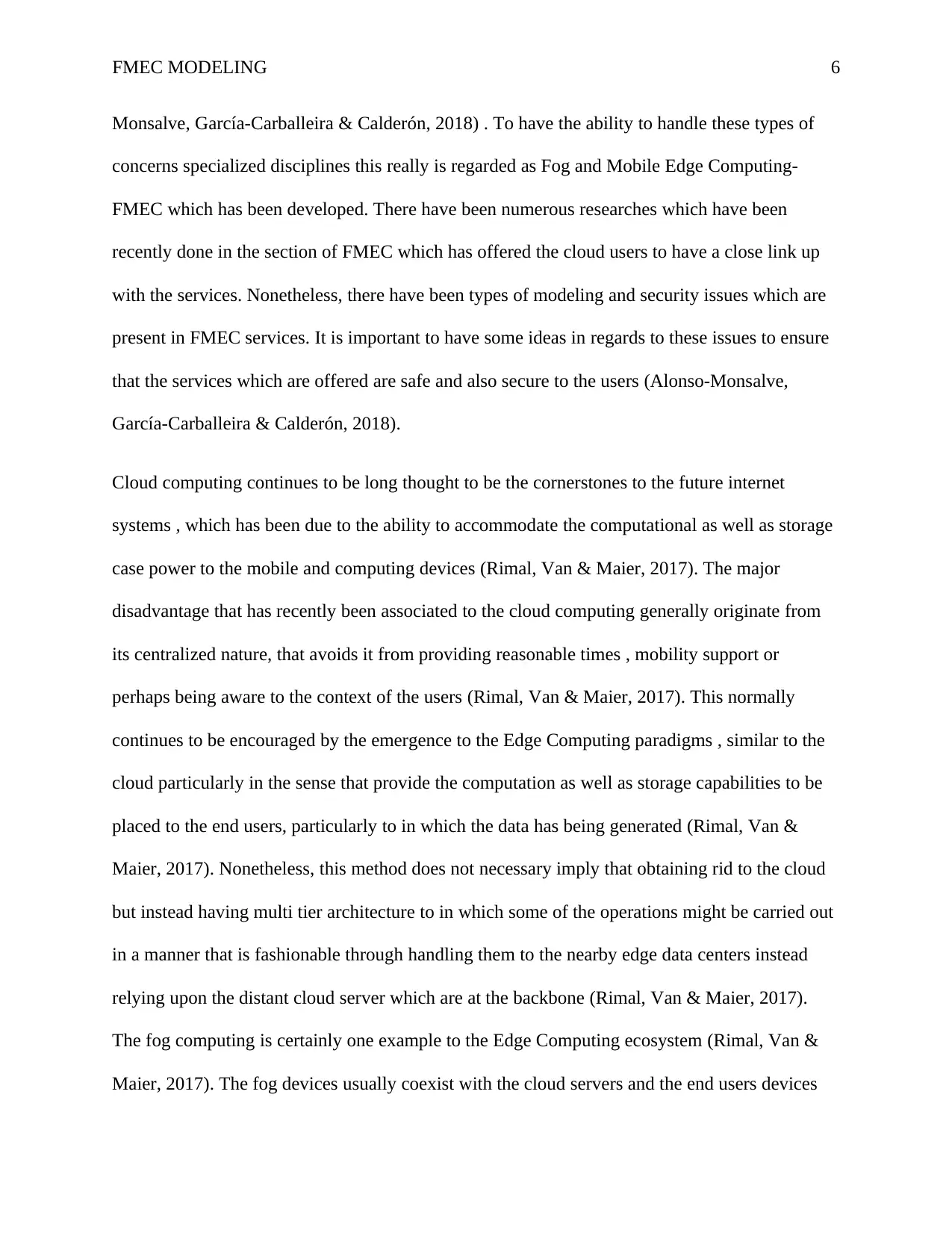
FMEC MODELING 6
Monsalve, García-Carballeira & Calderón, 2018) . To have the ability to handle these types of
concerns specialized disciplines this really is regarded as Fog and Mobile Edge Computing-
FMEC which has been developed. There have been numerous researches which have been
recently done in the section of FMEC which has offered the cloud users to have a close link up
with the services. Nonetheless, there have been types of modeling and security issues which are
present in FMEC services. It is important to have some ideas in regards to these issues to ensure
that the services which are offered are safe and also secure to the users (Alonso-Monsalve,
García-Carballeira & Calderón, 2018).
Cloud computing continues to be long thought to be the cornerstones to the future internet
systems , which has been due to the ability to accommodate the computational as well as storage
case power to the mobile and computing devices (Rimal, Van & Maier, 2017). The major
disadvantage that has recently been associated to the cloud computing generally originate from
its centralized nature, that avoids it from providing reasonable times , mobility support or
perhaps being aware to the context of the users (Rimal, Van & Maier, 2017). This normally
continues to be encouraged by the emergence to the Edge Computing paradigms , similar to the
cloud particularly in the sense that provide the computation as well as storage capabilities to be
placed to the end users, particularly to in which the data has being generated (Rimal, Van &
Maier, 2017). Nonetheless, this method does not necessary imply that obtaining rid to the cloud
but instead having multi tier architecture to in which some of the operations might be carried out
in a manner that is fashionable through handling them to the nearby edge data centers instead
relying upon the distant cloud server which are at the backbone (Rimal, Van & Maier, 2017).
The fog computing is certainly one example to the Edge Computing ecosystem (Rimal, Van &
Maier, 2017). The fog devices usually coexist with the cloud servers and the end users devices
Monsalve, García-Carballeira & Calderón, 2018) . To have the ability to handle these types of
concerns specialized disciplines this really is regarded as Fog and Mobile Edge Computing-
FMEC which has been developed. There have been numerous researches which have been
recently done in the section of FMEC which has offered the cloud users to have a close link up
with the services. Nonetheless, there have been types of modeling and security issues which are
present in FMEC services. It is important to have some ideas in regards to these issues to ensure
that the services which are offered are safe and also secure to the users (Alonso-Monsalve,
García-Carballeira & Calderón, 2018).
Cloud computing continues to be long thought to be the cornerstones to the future internet
systems , which has been due to the ability to accommodate the computational as well as storage
case power to the mobile and computing devices (Rimal, Van & Maier, 2017). The major
disadvantage that has recently been associated to the cloud computing generally originate from
its centralized nature, that avoids it from providing reasonable times , mobility support or
perhaps being aware to the context of the users (Rimal, Van & Maier, 2017). This normally
continues to be encouraged by the emergence to the Edge Computing paradigms , similar to the
cloud particularly in the sense that provide the computation as well as storage capabilities to be
placed to the end users, particularly to in which the data has being generated (Rimal, Van &
Maier, 2017). Nonetheless, this method does not necessary imply that obtaining rid to the cloud
but instead having multi tier architecture to in which some of the operations might be carried out
in a manner that is fashionable through handling them to the nearby edge data centers instead
relying upon the distant cloud server which are at the backbone (Rimal, Van & Maier, 2017).
The fog computing is certainly one example to the Edge Computing ecosystem (Rimal, Van &
Maier, 2017). The fog devices usually coexist with the cloud servers and the end users devices
⊘ This is a preview!⊘
Do you want full access?
Subscribe today to unlock all pages.

Trusted by 1+ million students worldwide
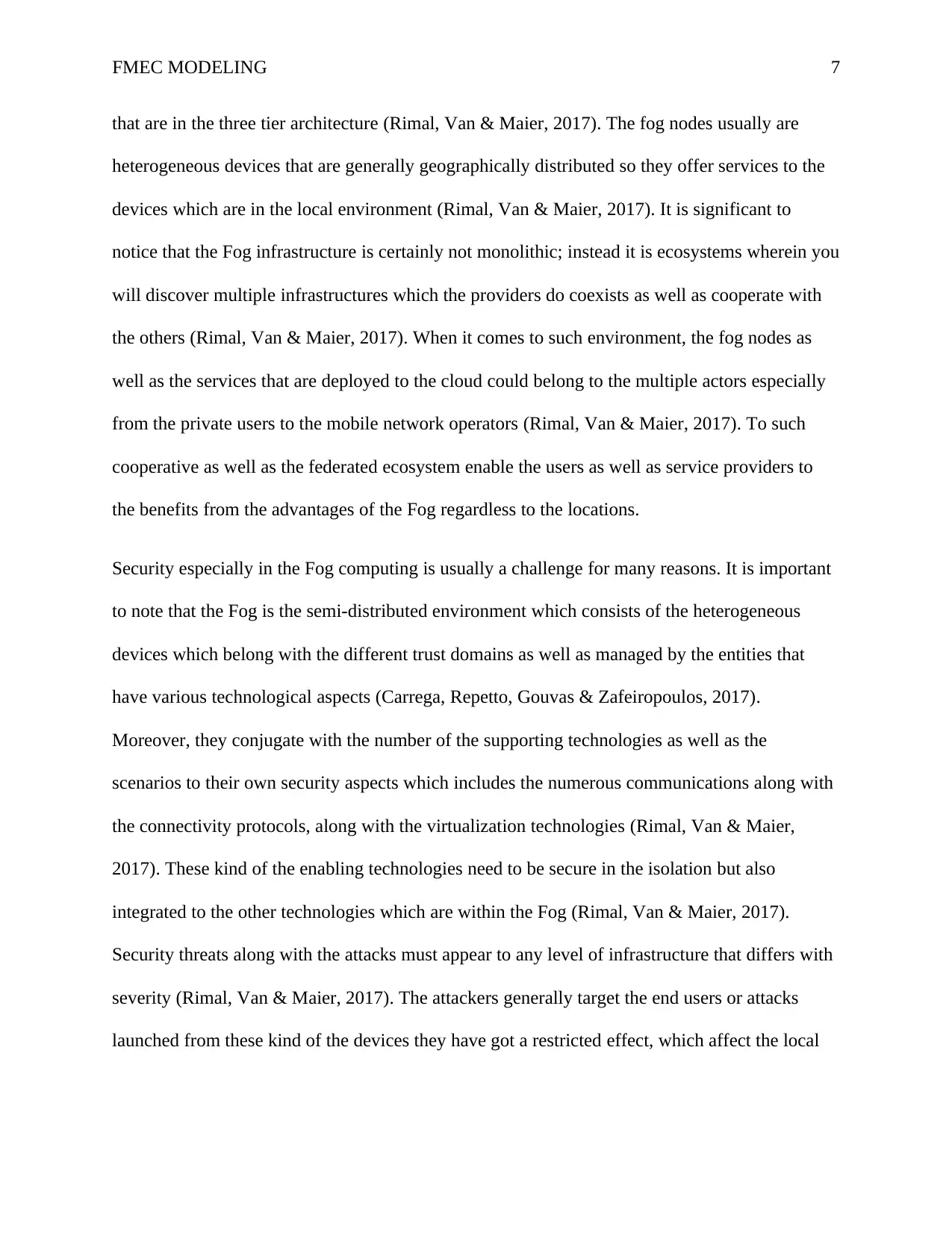
FMEC MODELING 7
that are in the three tier architecture (Rimal, Van & Maier, 2017). The fog nodes usually are
heterogeneous devices that are generally geographically distributed so they offer services to the
devices which are in the local environment (Rimal, Van & Maier, 2017). It is significant to
notice that the Fog infrastructure is certainly not monolithic; instead it is ecosystems wherein you
will discover multiple infrastructures which the providers do coexists as well as cooperate with
the others (Rimal, Van & Maier, 2017). When it comes to such environment, the fog nodes as
well as the services that are deployed to the cloud could belong to the multiple actors especially
from the private users to the mobile network operators (Rimal, Van & Maier, 2017). To such
cooperative as well as the federated ecosystem enable the users as well as service providers to
the benefits from the advantages of the Fog regardless to the locations.
Security especially in the Fog computing is usually a challenge for many reasons. It is important
to note that the Fog is the semi-distributed environment which consists of the heterogeneous
devices which belong with the different trust domains as well as managed by the entities that
have various technological aspects (Carrega, Repetto, Gouvas & Zafeiropoulos, 2017).
Moreover, they conjugate with the number of the supporting technologies as well as the
scenarios to their own security aspects which includes the numerous communications along with
the connectivity protocols, along with the virtualization technologies (Rimal, Van & Maier,
2017). These kind of the enabling technologies need to be secure in the isolation but also
integrated to the other technologies which are within the Fog (Rimal, Van & Maier, 2017).
Security threats along with the attacks must appear to any level of infrastructure that differs with
severity (Rimal, Van & Maier, 2017). The attackers generally target the end users or attacks
launched from these kind of the devices they have got a restricted effect, which affect the local
that are in the three tier architecture (Rimal, Van & Maier, 2017). The fog nodes usually are
heterogeneous devices that are generally geographically distributed so they offer services to the
devices which are in the local environment (Rimal, Van & Maier, 2017). It is significant to
notice that the Fog infrastructure is certainly not monolithic; instead it is ecosystems wherein you
will discover multiple infrastructures which the providers do coexists as well as cooperate with
the others (Rimal, Van & Maier, 2017). When it comes to such environment, the fog nodes as
well as the services that are deployed to the cloud could belong to the multiple actors especially
from the private users to the mobile network operators (Rimal, Van & Maier, 2017). To such
cooperative as well as the federated ecosystem enable the users as well as service providers to
the benefits from the advantages of the Fog regardless to the locations.
Security especially in the Fog computing is usually a challenge for many reasons. It is important
to note that the Fog is the semi-distributed environment which consists of the heterogeneous
devices which belong with the different trust domains as well as managed by the entities that
have various technological aspects (Carrega, Repetto, Gouvas & Zafeiropoulos, 2017).
Moreover, they conjugate with the number of the supporting technologies as well as the
scenarios to their own security aspects which includes the numerous communications along with
the connectivity protocols, along with the virtualization technologies (Rimal, Van & Maier,
2017). These kind of the enabling technologies need to be secure in the isolation but also
integrated to the other technologies which are within the Fog (Rimal, Van & Maier, 2017).
Security threats along with the attacks must appear to any level of infrastructure that differs with
severity (Rimal, Van & Maier, 2017). The attackers generally target the end users or attacks
launched from these kind of the devices they have got a restricted effect, which affect the local
Paraphrase This Document
Need a fresh take? Get an instant paraphrase of this document with our AI Paraphraser
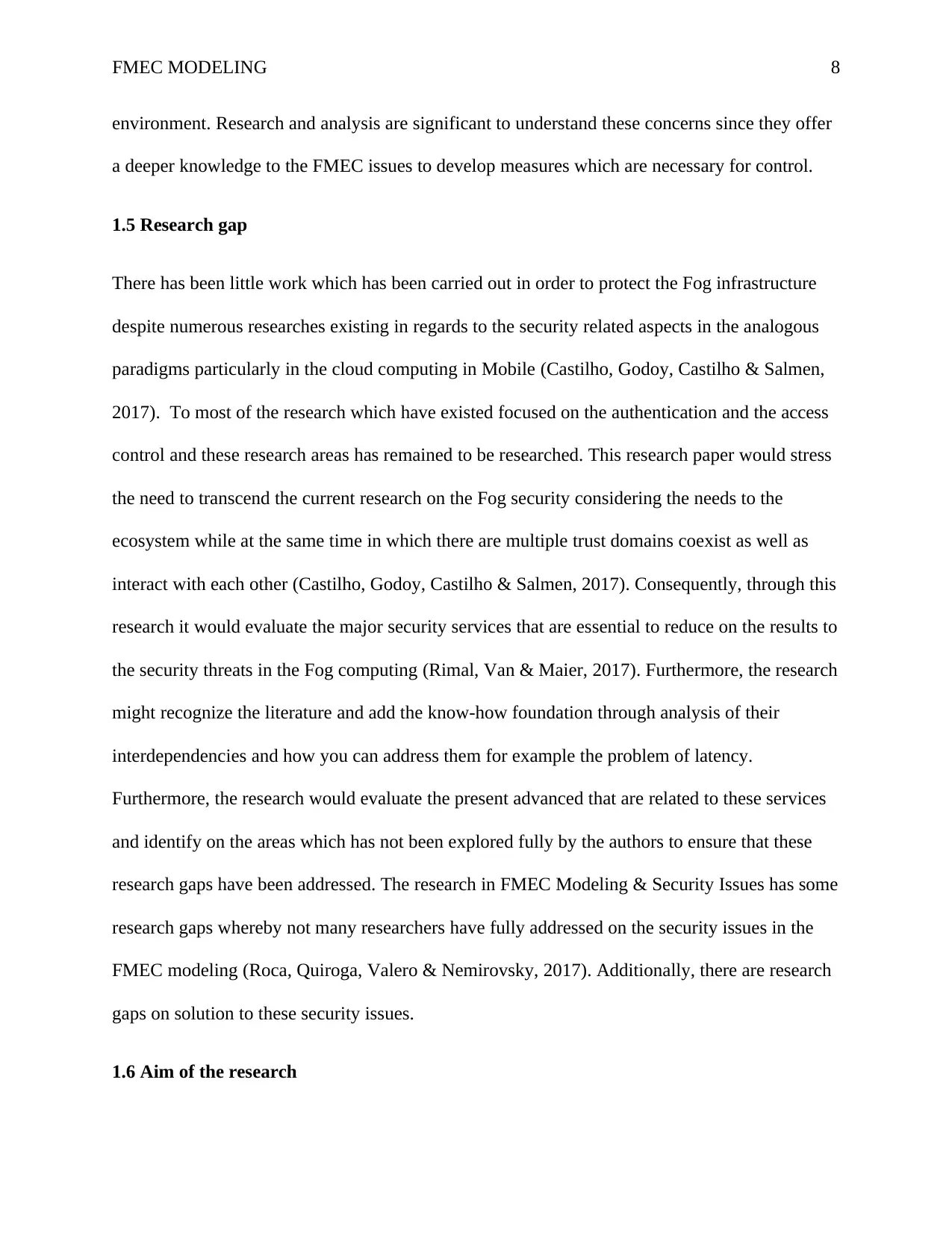
FMEC MODELING 8
environment. Research and analysis are significant to understand these concerns since they offer
a deeper knowledge to the FMEC issues to develop measures which are necessary for control.
1.5 Research gap
There has been little work which has been carried out in order to protect the Fog infrastructure
despite numerous researches existing in regards to the security related aspects in the analogous
paradigms particularly in the cloud computing in Mobile (Castilho, Godoy, Castilho & Salmen,
2017). To most of the research which have existed focused on the authentication and the access
control and these research areas has remained to be researched. This research paper would stress
the need to transcend the current research on the Fog security considering the needs to the
ecosystem while at the same time in which there are multiple trust domains coexist as well as
interact with each other (Castilho, Godoy, Castilho & Salmen, 2017). Consequently, through this
research it would evaluate the major security services that are essential to reduce on the results to
the security threats in the Fog computing (Rimal, Van & Maier, 2017). Furthermore, the research
might recognize the literature and add the know-how foundation through analysis of their
interdependencies and how you can address them for example the problem of latency.
Furthermore, the research would evaluate the present advanced that are related to these services
and identify on the areas which has not been explored fully by the authors to ensure that these
research gaps have been addressed. The research in FMEC Modeling & Security Issues has some
research gaps whereby not many researchers have fully addressed on the security issues in the
FMEC modeling (Roca, Quiroga, Valero & Nemirovsky, 2017). Additionally, there are research
gaps on solution to these security issues.
1.6 Aim of the research
environment. Research and analysis are significant to understand these concerns since they offer
a deeper knowledge to the FMEC issues to develop measures which are necessary for control.
1.5 Research gap
There has been little work which has been carried out in order to protect the Fog infrastructure
despite numerous researches existing in regards to the security related aspects in the analogous
paradigms particularly in the cloud computing in Mobile (Castilho, Godoy, Castilho & Salmen,
2017). To most of the research which have existed focused on the authentication and the access
control and these research areas has remained to be researched. This research paper would stress
the need to transcend the current research on the Fog security considering the needs to the
ecosystem while at the same time in which there are multiple trust domains coexist as well as
interact with each other (Castilho, Godoy, Castilho & Salmen, 2017). Consequently, through this
research it would evaluate the major security services that are essential to reduce on the results to
the security threats in the Fog computing (Rimal, Van & Maier, 2017). Furthermore, the research
might recognize the literature and add the know-how foundation through analysis of their
interdependencies and how you can address them for example the problem of latency.
Furthermore, the research would evaluate the present advanced that are related to these services
and identify on the areas which has not been explored fully by the authors to ensure that these
research gaps have been addressed. The research in FMEC Modeling & Security Issues has some
research gaps whereby not many researchers have fully addressed on the security issues in the
FMEC modeling (Roca, Quiroga, Valero & Nemirovsky, 2017). Additionally, there are research
gaps on solution to these security issues.
1.6 Aim of the research
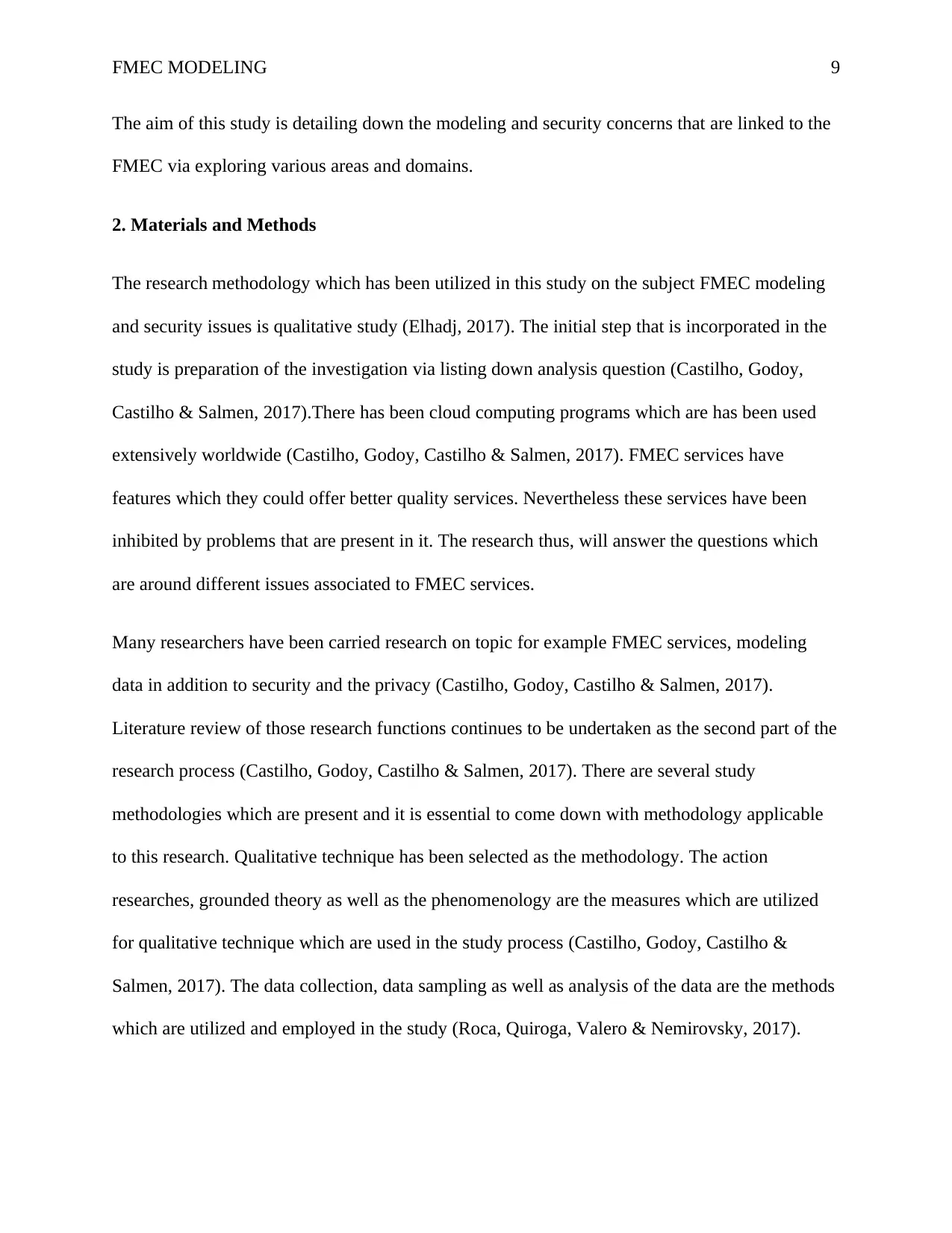
FMEC MODELING 9
The aim of this study is detailing down the modeling and security concerns that are linked to the
FMEC via exploring various areas and domains.
2. Materials and Methods
The research methodology which has been utilized in this study on the subject FMEC modeling
and security issues is qualitative study (Elhadj, 2017). The initial step that is incorporated in the
study is preparation of the investigation via listing down analysis question (Castilho, Godoy,
Castilho & Salmen, 2017).There has been cloud computing programs which are has been used
extensively worldwide (Castilho, Godoy, Castilho & Salmen, 2017). FMEC services have
features which they could offer better quality services. Nevertheless these services have been
inhibited by problems that are present in it. The research thus, will answer the questions which
are around different issues associated to FMEC services.
Many researchers have been carried research on topic for example FMEC services, modeling
data in addition to security and the privacy (Castilho, Godoy, Castilho & Salmen, 2017).
Literature review of those research functions continues to be undertaken as the second part of the
research process (Castilho, Godoy, Castilho & Salmen, 2017). There are several study
methodologies which are present and it is essential to come down with methodology applicable
to this research. Qualitative technique has been selected as the methodology. The action
researches, grounded theory as well as the phenomenology are the measures which are utilized
for qualitative technique which are used in the study process (Castilho, Godoy, Castilho &
Salmen, 2017). The data collection, data sampling as well as analysis of the data are the methods
which are utilized and employed in the study (Roca, Quiroga, Valero & Nemirovsky, 2017).
The aim of this study is detailing down the modeling and security concerns that are linked to the
FMEC via exploring various areas and domains.
2. Materials and Methods
The research methodology which has been utilized in this study on the subject FMEC modeling
and security issues is qualitative study (Elhadj, 2017). The initial step that is incorporated in the
study is preparation of the investigation via listing down analysis question (Castilho, Godoy,
Castilho & Salmen, 2017).There has been cloud computing programs which are has been used
extensively worldwide (Castilho, Godoy, Castilho & Salmen, 2017). FMEC services have
features which they could offer better quality services. Nevertheless these services have been
inhibited by problems that are present in it. The research thus, will answer the questions which
are around different issues associated to FMEC services.
Many researchers have been carried research on topic for example FMEC services, modeling
data in addition to security and the privacy (Castilho, Godoy, Castilho & Salmen, 2017).
Literature review of those research functions continues to be undertaken as the second part of the
research process (Castilho, Godoy, Castilho & Salmen, 2017). There are several study
methodologies which are present and it is essential to come down with methodology applicable
to this research. Qualitative technique has been selected as the methodology. The action
researches, grounded theory as well as the phenomenology are the measures which are utilized
for qualitative technique which are used in the study process (Castilho, Godoy, Castilho &
Salmen, 2017). The data collection, data sampling as well as analysis of the data are the methods
which are utilized and employed in the study (Roca, Quiroga, Valero & Nemirovsky, 2017).
⊘ This is a preview!⊘
Do you want full access?
Subscribe today to unlock all pages.

Trusted by 1+ million students worldwide
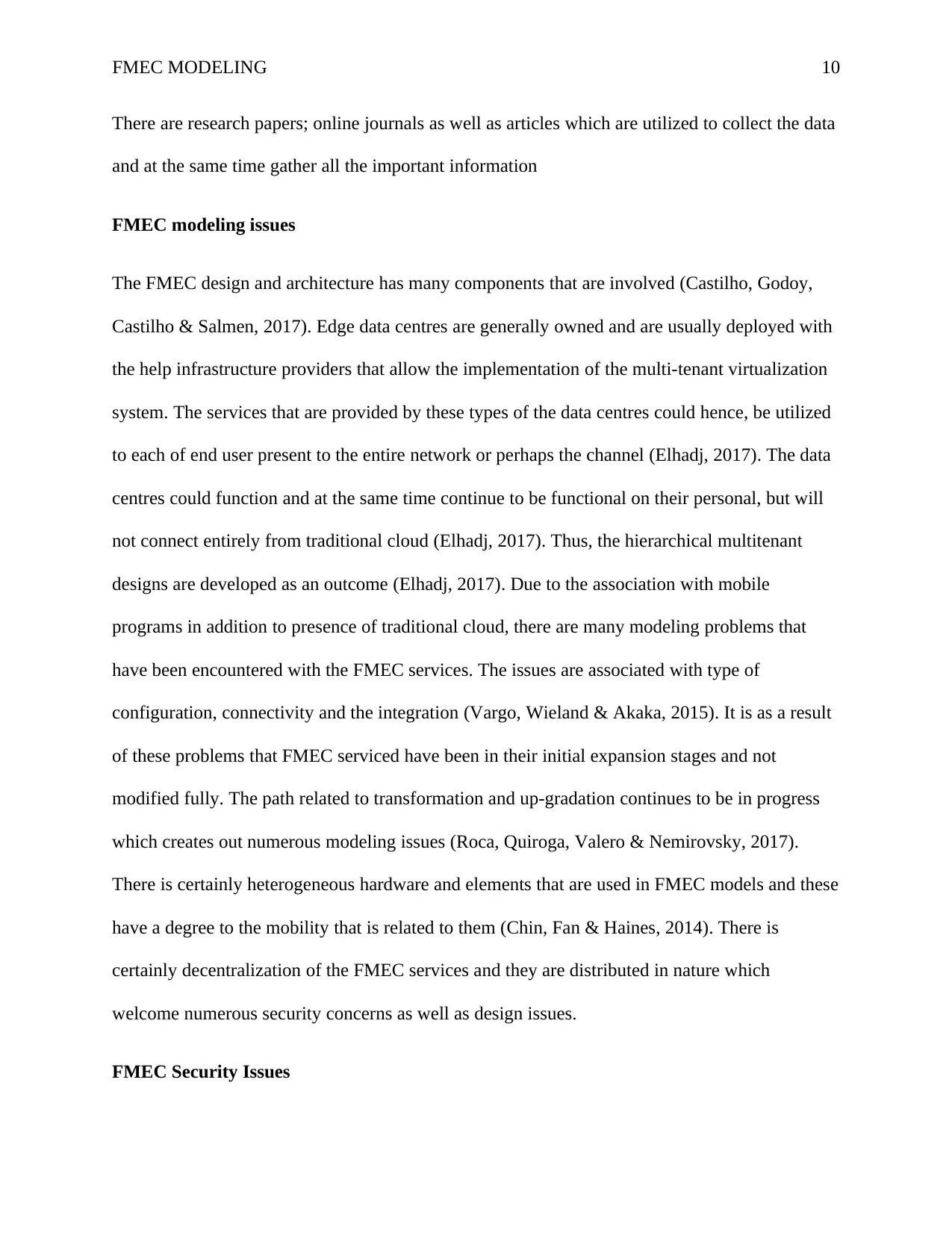
FMEC MODELING 10
There are research papers; online journals as well as articles which are utilized to collect the data
and at the same time gather all the important information
FMEC modeling issues
The FMEC design and architecture has many components that are involved (Castilho, Godoy,
Castilho & Salmen, 2017). Edge data centres are generally owned and are usually deployed with
the help infrastructure providers that allow the implementation of the multi-tenant virtualization
system. The services that are provided by these types of the data centres could hence, be utilized
to each of end user present to the entire network or perhaps the channel (Elhadj, 2017). The data
centres could function and at the same time continue to be functional on their personal, but will
not connect entirely from traditional cloud (Elhadj, 2017). Thus, the hierarchical multitenant
designs are developed as an outcome (Elhadj, 2017). Due to the association with mobile
programs in addition to presence of traditional cloud, there are many modeling problems that
have been encountered with the FMEC services. The issues are associated with type of
configuration, connectivity and the integration (Vargo, Wieland & Akaka, 2015). It is as a result
of these problems that FMEC serviced have been in their initial expansion stages and not
modified fully. The path related to transformation and up-gradation continues to be in progress
which creates out numerous modeling issues (Roca, Quiroga, Valero & Nemirovsky, 2017).
There is certainly heterogeneous hardware and elements that are used in FMEC models and these
have a degree to the mobility that is related to them (Chin, Fan & Haines, 2014). There is
certainly decentralization of the FMEC services and they are distributed in nature which
welcome numerous security concerns as well as design issues.
FMEC Security Issues
There are research papers; online journals as well as articles which are utilized to collect the data
and at the same time gather all the important information
FMEC modeling issues
The FMEC design and architecture has many components that are involved (Castilho, Godoy,
Castilho & Salmen, 2017). Edge data centres are generally owned and are usually deployed with
the help infrastructure providers that allow the implementation of the multi-tenant virtualization
system. The services that are provided by these types of the data centres could hence, be utilized
to each of end user present to the entire network or perhaps the channel (Elhadj, 2017). The data
centres could function and at the same time continue to be functional on their personal, but will
not connect entirely from traditional cloud (Elhadj, 2017). Thus, the hierarchical multitenant
designs are developed as an outcome (Elhadj, 2017). Due to the association with mobile
programs in addition to presence of traditional cloud, there are many modeling problems that
have been encountered with the FMEC services. The issues are associated with type of
configuration, connectivity and the integration (Vargo, Wieland & Akaka, 2015). It is as a result
of these problems that FMEC serviced have been in their initial expansion stages and not
modified fully. The path related to transformation and up-gradation continues to be in progress
which creates out numerous modeling issues (Roca, Quiroga, Valero & Nemirovsky, 2017).
There is certainly heterogeneous hardware and elements that are used in FMEC models and these
have a degree to the mobility that is related to them (Chin, Fan & Haines, 2014). There is
certainly decentralization of the FMEC services and they are distributed in nature which
welcome numerous security concerns as well as design issues.
FMEC Security Issues
Paraphrase This Document
Need a fresh take? Get an instant paraphrase of this document with our AI Paraphraser
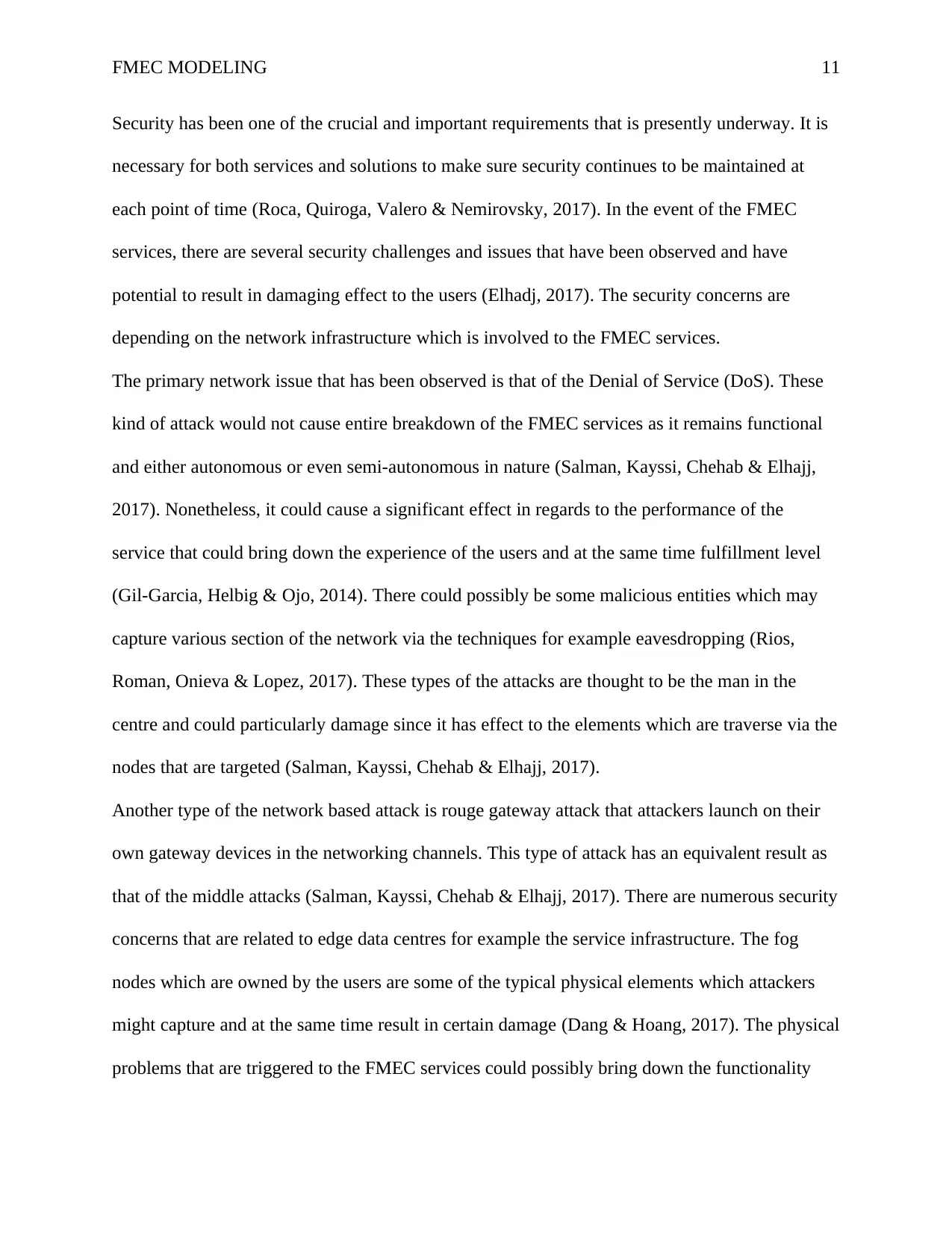
FMEC MODELING 11
Security has been one of the crucial and important requirements that is presently underway. It is
necessary for both services and solutions to make sure security continues to be maintained at
each point of time (Roca, Quiroga, Valero & Nemirovsky, 2017). In the event of the FMEC
services, there are several security challenges and issues that have been observed and have
potential to result in damaging effect to the users (Elhadj, 2017). The security concerns are
depending on the network infrastructure which is involved to the FMEC services.
The primary network issue that has been observed is that of the Denial of Service (DoS). These
kind of attack would not cause entire breakdown of the FMEC services as it remains functional
and either autonomous or even semi-autonomous in nature (Salman, Kayssi, Chehab & Elhajj,
2017). Nonetheless, it could cause a significant effect in regards to the performance of the
service that could bring down the experience of the users and at the same time fulfillment level
(Gil-Garcia, Helbig & Ojo, 2014). There could possibly be some malicious entities which may
capture various section of the network via the techniques for example eavesdropping (Rios,
Roman, Onieva & Lopez, 2017). These types of the attacks are thought to be the man in the
centre and could particularly damage since it has effect to the elements which are traverse via the
nodes that are targeted (Salman, Kayssi, Chehab & Elhajj, 2017).
Another type of the network based attack is rouge gateway attack that attackers launch on their
own gateway devices in the networking channels. This type of attack has an equivalent result as
that of the middle attacks (Salman, Kayssi, Chehab & Elhajj, 2017). There are numerous security
concerns that are related to edge data centres for example the service infrastructure. The fog
nodes which are owned by the users are some of the typical physical elements which attackers
might capture and at the same time result in certain damage (Dang & Hoang, 2017). The physical
problems that are triggered to the FMEC services could possibly bring down the functionality
Security has been one of the crucial and important requirements that is presently underway. It is
necessary for both services and solutions to make sure security continues to be maintained at
each point of time (Roca, Quiroga, Valero & Nemirovsky, 2017). In the event of the FMEC
services, there are several security challenges and issues that have been observed and have
potential to result in damaging effect to the users (Elhadj, 2017). The security concerns are
depending on the network infrastructure which is involved to the FMEC services.
The primary network issue that has been observed is that of the Denial of Service (DoS). These
kind of attack would not cause entire breakdown of the FMEC services as it remains functional
and either autonomous or even semi-autonomous in nature (Salman, Kayssi, Chehab & Elhajj,
2017). Nonetheless, it could cause a significant effect in regards to the performance of the
service that could bring down the experience of the users and at the same time fulfillment level
(Gil-Garcia, Helbig & Ojo, 2014). There could possibly be some malicious entities which may
capture various section of the network via the techniques for example eavesdropping (Rios,
Roman, Onieva & Lopez, 2017). These types of the attacks are thought to be the man in the
centre and could particularly damage since it has effect to the elements which are traverse via the
nodes that are targeted (Salman, Kayssi, Chehab & Elhajj, 2017).
Another type of the network based attack is rouge gateway attack that attackers launch on their
own gateway devices in the networking channels. This type of attack has an equivalent result as
that of the middle attacks (Salman, Kayssi, Chehab & Elhajj, 2017). There are numerous security
concerns that are related to edge data centres for example the service infrastructure. The fog
nodes which are owned by the users are some of the typical physical elements which attackers
might capture and at the same time result in certain damage (Dang & Hoang, 2017). The physical
problems that are triggered to the FMEC services could possibly bring down the functionality
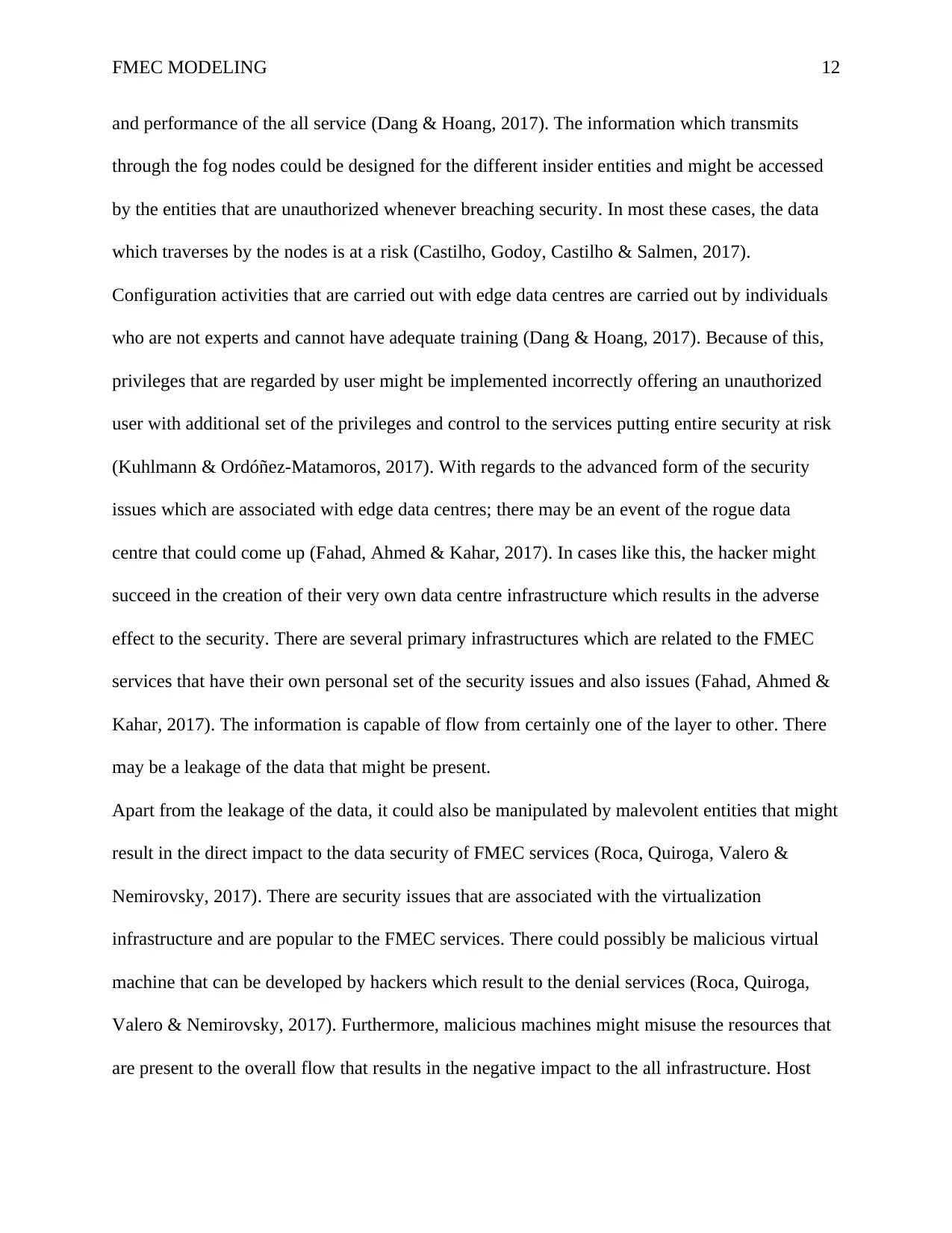
FMEC MODELING 12
and performance of the all service (Dang & Hoang, 2017). The information which transmits
through the fog nodes could be designed for the different insider entities and might be accessed
by the entities that are unauthorized whenever breaching security. In most these cases, the data
which traverses by the nodes is at a risk (Castilho, Godoy, Castilho & Salmen, 2017).
Configuration activities that are carried out with edge data centres are carried out by individuals
who are not experts and cannot have adequate training (Dang & Hoang, 2017). Because of this,
privileges that are regarded by user might be implemented incorrectly offering an unauthorized
user with additional set of the privileges and control to the services putting entire security at risk
(Kuhlmann & Ordóñez-Matamoros, 2017). With regards to the advanced form of the security
issues which are associated with edge data centres; there may be an event of the rogue data
centre that could come up (Fahad, Ahmed & Kahar, 2017). In cases like this, the hacker might
succeed in the creation of their very own data centre infrastructure which results in the adverse
effect to the security. There are several primary infrastructures which are related to the FMEC
services that have their own personal set of the security issues and also issues (Fahad, Ahmed &
Kahar, 2017). The information is capable of flow from certainly one of the layer to other. There
may be a leakage of the data that might be present.
Apart from the leakage of the data, it could also be manipulated by malevolent entities that might
result in the direct impact to the data security of FMEC services (Roca, Quiroga, Valero &
Nemirovsky, 2017). There are security issues that are associated with the virtualization
infrastructure and are popular to the FMEC services. There could possibly be malicious virtual
machine that can be developed by hackers which result to the denial services (Roca, Quiroga,
Valero & Nemirovsky, 2017). Furthermore, malicious machines might misuse the resources that
are present to the overall flow that results in the negative impact to the all infrastructure. Host
and performance of the all service (Dang & Hoang, 2017). The information which transmits
through the fog nodes could be designed for the different insider entities and might be accessed
by the entities that are unauthorized whenever breaching security. In most these cases, the data
which traverses by the nodes is at a risk (Castilho, Godoy, Castilho & Salmen, 2017).
Configuration activities that are carried out with edge data centres are carried out by individuals
who are not experts and cannot have adequate training (Dang & Hoang, 2017). Because of this,
privileges that are regarded by user might be implemented incorrectly offering an unauthorized
user with additional set of the privileges and control to the services putting entire security at risk
(Kuhlmann & Ordóñez-Matamoros, 2017). With regards to the advanced form of the security
issues which are associated with edge data centres; there may be an event of the rogue data
centre that could come up (Fahad, Ahmed & Kahar, 2017). In cases like this, the hacker might
succeed in the creation of their very own data centre infrastructure which results in the adverse
effect to the security. There are several primary infrastructures which are related to the FMEC
services that have their own personal set of the security issues and also issues (Fahad, Ahmed &
Kahar, 2017). The information is capable of flow from certainly one of the layer to other. There
may be a leakage of the data that might be present.
Apart from the leakage of the data, it could also be manipulated by malevolent entities that might
result in the direct impact to the data security of FMEC services (Roca, Quiroga, Valero &
Nemirovsky, 2017). There are security issues that are associated with the virtualization
infrastructure and are popular to the FMEC services. There could possibly be malicious virtual
machine that can be developed by hackers which result to the denial services (Roca, Quiroga,
Valero & Nemirovsky, 2017). Furthermore, malicious machines might misuse the resources that
are present to the overall flow that results in the negative impact to the all infrastructure. Host
⊘ This is a preview!⊘
Do you want full access?
Subscribe today to unlock all pages.

Trusted by 1+ million students worldwide
1 out of 21
Related Documents
Your All-in-One AI-Powered Toolkit for Academic Success.
+13062052269
info@desklib.com
Available 24*7 on WhatsApp / Email
![[object Object]](/_next/static/media/star-bottom.7253800d.svg)
Unlock your academic potential
Copyright © 2020–2025 A2Z Services. All Rights Reserved. Developed and managed by ZUCOL.




